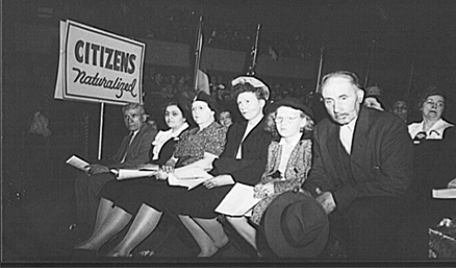Each September, Americans commemorate the anniversary of the signing of the Constitution with two federally recognized celebrations: Constitution Day and Citizenship Day. But how did these events combine to become a single civic holiday intended to provide for “the complete instruction of citizens in their responsibilities and opportunities as citizens of the United States and of the State and locality in which they reside?”
 A 1954 law passed during the Cold War to promote citizenship was amended in 2004 to include those words, but separate efforts to celebrate Constitution Day date back to at least the early 20th century—well before the president and Congress moved to recognize the day when 39 delegates signed the Constitution in Philadelphia on Sept. 17, 1787.
A 1954 law passed during the Cold War to promote citizenship was amended in 2004 to include those words, but separate efforts to celebrate Constitution Day date back to at least the early 20th century—well before the president and Congress moved to recognize the day when 39 delegates signed the Constitution in Philadelphia on Sept. 17, 1787.
Early Efforts
Early Constitution Day celebrations were observed by some fraternal organizations, including the National Security League, which advocated for a national Constitution Day holiday. The controversial World War I-era nationalist group also supported the Alien and Sedition Acts promoted by the Wilson administration.
“The aim of this great nation-wide constitutional campaign and celebration, planned by the eight leading national patriotic societies under the leadership of the National Security League, is to strengthen the faith of the people of America in the constitution of the United States by means of a popular exposition of its essential doctrines,” a spokesperson told the Allentown Morning Call in 1919. School authorities in more than 40 states were asked to hold “suitable exercises in every classroom under their jurisdiction” on Sept. 17 each year.
While the National Security League faded away over time, Constitution Day activities became widely adopted at a grassroots level. A typical Constitution Day observance in an 8th grade classroom in 1934, as reported in the Biddeford Daily Journal in Maine, started with a salute and the Pledge of Allegiance to the flag, followed by a class reading of the Constitution’s Preamble. Students then discussed and debated the 19th, 20th, and 21st Amendments to the Constitution.
The Birth of Citizenship Day
In the late 1930s, a separate effort led to what later became Citizenship Day. Publisher William Randolph Hearst promoted the idea of a new holiday called “I Am an American Day,” after his newspapers covered several local observances. In 1940, President Franklin D. Roosevelt signed a joint congressional resolution proclaiming the celebration. According to the Immigration and Naturalization Service, the event was “a day to honor those whose voluntary allegiance to the United States has given them citizenship through naturalization, and those who have most recently come into responsible citizenship by reaching maturity.”
The event was observed on the third Sunday in May, and perhaps the biggest event occurred on May 21, 1944. A crowd of 1.5 million people gathered in New York’s Central Park—including 110,000 new citizens—to listen to Judge Learned Hand speak about the meaning of freedom and liberty.
In 1952, President Harry Truman signed a bill renaming the event “Citizenship Day,” with the observed date moved to Sept. 17—the same day still observed as Constitution Day in many states and local communities. In his annual proclamation, Truman made a direct link between the two events: “It is most fitting that every citizen of the United States, whether native-born or foreign-born, should on September 17 of each year give special thought and consideration to his rights and responsibilities under our Constitution.” In 1956, the event was expanded when President Dwight Eisenhower included Constitution Week—observed from Sept. 17-23—in his annual proclamation.
Constitution Day Recognized by Congress
In 1997, Louise Leigh, a retired medical technologist in California, started her own grassroots campaign to have Congress recognize Constitution Day as its own national holiday. Leigh was concerned about a general lack of constitutional literacy. “I spoke on university campuses and schools and service clubs and realized how little people knew about the Constitution,” Leigh, who was then 91 years old, told The Los Angeles Times in 2005.
Senator Robert Byrd of West Virginia added language to an omnibus bill passed by Congress in December 2004 that established the event observed today. Under 36 U.S. Code § 106, Constitution Day and Citizenship Day became a combined event that also can be held on a different date if Sept. 17 falls on a weekend. The law also requires that “each educational institution that receives Federal funds for a fiscal year shall hold an educational program on the United States Constitution on September 17 of such year for the students served by the educational institution.”
It was noted in Leigh’s 2006 obituary that she promoted Constitution Day “to organize school children, overseas military and governors to recite the Preamble to the Constitution simultaneously on September 17th across the country.”
Scott Bomboy is the editor in chief of the National Constitution Center.
Related Resources from the National Constitution Center
Website: Constitution Day Resources for Educators and Students
Event: 236th Anniversary of the Signing of the Constitution With Free Admission







